I arrived in Tokyo late into the evening. Rush hour. The subway was full of sararimans, corporate workers dressed in suits in varying dark shades, either staring distracted into their screens or blankly at their own reflections against the glass. There was a jingle, then an announcement of the coming station. I only recognised the words I had memorised long before I arrived the city: Shinjuku-Gyoen.
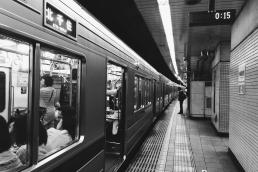
As I stepped out to the pavement above the ground, light shower pelted against my head. The rain blurred the colourful neon lights that surrounded me. I had come a long way from Kyoto, Japan’s former historical capital – to the nation’s aspiration for its future: Tokyo.
There was no scattering of low-levelled residential flats and temples here. No – not since the Emperor moved the nation’s seat of power from Kyoto to Tokyo in 1868. Tall glass buildings, neon lights and an incredibly efficient public transportation system was Japan’s way forward. And the city expressed it clearly to me, its lights guiding me in the evening shower.
After Kyoto, the cultural attractions one sets for the sprawling metropolis can likely dip a little in the face of skyscrapers and urbanites hurrying to work. Despite this, pockets of serenity exists in its city parks, notably the Shinjuku Gyoen, one of Tokyo’s most popular especially during the spring when families and friends sit on the perfectly-manicured greens, observing the blooming of the cherry blossoms.
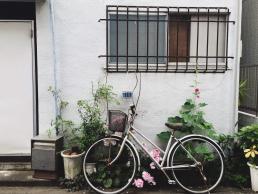
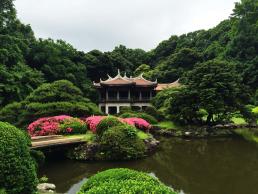
Despite how busy life in the city may get, even with an unforgiving work culture that drives so many to their death – the park and its protective wall of trees is but an underscore towards the enduring quality of Japanese serenity, a quality in conflict with the hustle and bustle of corporate expectations. I mused my existence while observing elderly amateur artistes sketch and paint the temple across the lake before them, their light brush and pencil marks as delicate as their own lives.
But enclaves like Shinkuju Gyoen are rare, though healthily dotted throughout the metropolis. One only needs to travel to the southern tip of Tokyo to Odaiba to see a glimpse of how the near future will look like.

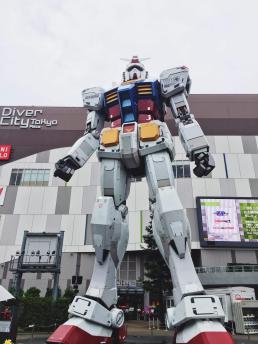
There is no doubt the aspirations of the future, both in Japan and beyond can be found on this man-made island. The futuristic architecture of the media-giant Fuji TV’s complex reminds one of a spaceship – ready to launch into an uncharted final frontier. As if that’s not statement enough, a little bit further into the island is an 18m-tall Mobile Suit Gundam statue, a staple of Japanese science fiction in media and literature.
Being an on-and-off fan of the Gundam series (based on specific favourite series), there is a thrill to imagine oneself as the robot’s pilot in the cockpit. Its blinking eye-pieces only serves to entice the imagination of fans who flock for a taste of a distant future when these machines become weapons.
And then, there’s Miraikan.
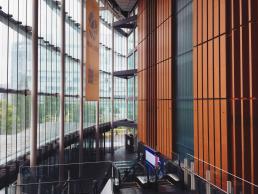
Opened in 2001, Miraikan literally translates as “Future Museum”. From its architecture right down to its clinical cafeteria, the science exhibition centre is a lens on the near future through current developing technology. I’ve been to my fair share of science centres over the decades, but I must confess that Miraikan’s exhibitions are grounded in the current while tipping over just enough to intrigue one’s imagination of the future.
It’s most notable for housing Honda’s popular adorable robot, Asimo. Miriakan gives you a taste of Japan’s technological direction – where we’re headed in five to 10 years time. Its special exhibitions change every few months, co-opting science and art to engage in issues related to environment, futurism, lifestyle and technology, among others.

It’s almost sunset and I leave the glass buildings behind to pursue a crossing on the iconic Rainbow Bridge. It’s often featured in a lot of Japanese animation and has become a pop cultural icon back-dropped against scenes of romance, sci-fi and many other anime features. While it derives its name from a spectrum of colours present during special celebrations, for most parts of the year, like this evening – the colours gracing the bridge are green and white.
The Rainbow Bridge is about 1.7km long and through the windy cold breeze, I walked from Odaiba to mainland Tokyo, witnessing the a sky of constantly evolving colours. From fiery amber dying into a pitch darkness, the iconic Tokyo Tower a beacon in the urban skyline.

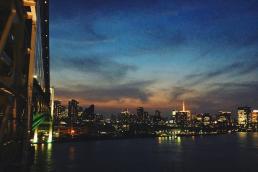
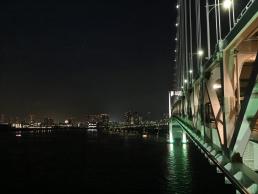
After a tiring day out in Odaiba, I lulled into a deep slumber, dreaming of the glittering Tokyo skyline. I would miss the legendary Tsukiji Market tuna auction, that starts at 5am and only admits an exclusive 120 visitors a day. For years, the market’s faced its eventual closure and relocation and today, like many others, continues to be flocked by locals and tourists alike.
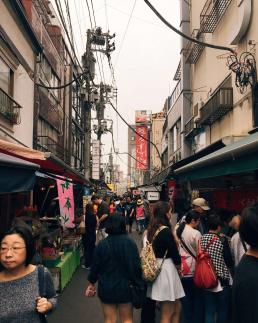
Outside Tsukiji Fish Market are lanes occupied by businesses serving up sushi, cookware, street food and sweets. I retreat to a sushi restaurant hidden behind noren, long strips of pastel cloth covering the interior and maintaining the privacy of its customers from the outside world. The chef looks up, smiles and shouts: “Irrashaimase!” I nod and acknowledge his welcome, taking a seat furthest from the door.
Moments later, his helper swoops by and passes me a laminated menu. It bore photographs of different cuts of colourful fresh fish with Japanese text accompanied by mini English subtitles. I smiled, ordered mizu (plain water) to begin with and examined both the menu and my appetite.
I observe a table of elderly gentlemen beside me, cans of Asahi beers on the table and their chatter barely audible. They noticed my gaze and I nodded with a smile – they smiled back. Gaijin, I was in their eyes. Foreigner. Though I was not the typical stock of Caucasian that this term is often associated with. Nevertheless, I was alien, different and unaccustomed. Gaijin afforded me ignorance but also inaccessibility. Opportunity but also restrictions.
Japan had over two centuries of isolation from the outside world until its ports were re-opened in the late 17th century. Its founding rationale laid in an attempt to restrict outside political and religious influences. Quite the contrary now, I thought, as I saw droves of Caucasians navigate their way through the maddening crowd outside. The American Occupation since the end of WWII had shaped much of the nation, and its participation with the outside world. But gaijin and what it entails will forever remain.
I put down my menu, ordering a range of tuna cuts. It’s no secret here that fatty tuna is what sushi connoisseurs would highly recommend, with a price to match. My eye caught on the word ‘whale’ – to which I quickly added to my order out of curiosity. Its taste, I must admit, was rather unique and difficult to describe. Only best here illustrated as silky with a generous amount of game.
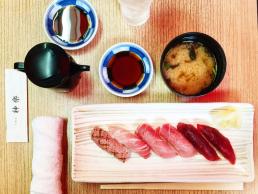
Back outside, the sun was already above our heads and noon was alight. The crowds had dwindled down and I walk past business-folks wrapping up the last of their sales. Tomorrow, it will begin all over again at the crack of dawn.
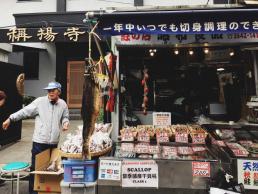
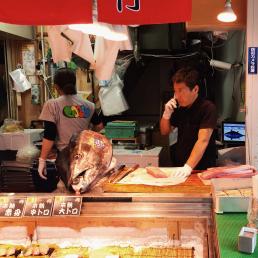
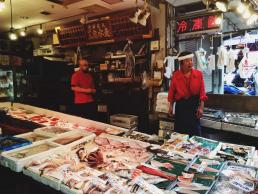
With the market now quiet, I head down to the subway and change trains to Akihabara. During the day, it’s hard to tell but as dusk sweeps over the cityscape and the neon lights turn on like fireflies – it’s easily to see why it earned the name: Tokyo’s Electric Town.
The Akihabara district is every otaku culturist’s heaven and end-all-be-all for those who are interested in gadgets and electronics. If you are a fan of a particular anime or manga series, chances are – this is the only place in the metropolis you’d be able to find related merchandise. I walked past streets of stores offering figurines, collectibles, comics, etc. Those more inclined towards geeking over Western pop culture (Star Wars, Marvel, DC, etc.) would also find themselves satisfied with an exhaustive catalogue.
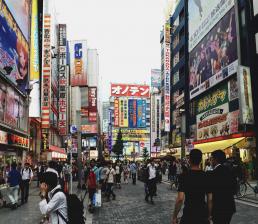
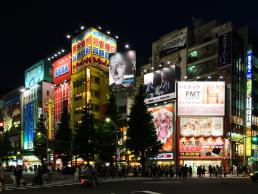
I relived my childhood by seeking out the Akihabara Gachapon Hall, housing over 400 machines with toy-contained capsules. Put in a coin, turn the lever and out pops a randomised toy. It’s a little like gambling for your favourite figurines, really. I could imagine frustrated individuals feeding coin after coin, hoping to get that one elusive figurine in a chance of one out of every 20 pops.
Despite this, the gachapon is not only exclusive to Akihabara. It can be found throughout the country as much as one stumbles upon vending machines.
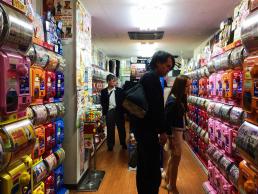
The next morning, I headed out to the Tokyo City Flea Market. Every weekend, the locally-run market operates from 9 in the morning and invites all forms of antiques and collectibles. It’s tempting to not return from this market with at least something purchased. Be it memorabilia or a second-hand kimono. I ended up purchasing a navy-blue summer yukata, the casual version of a kimono, from a kindly middle-aged man.
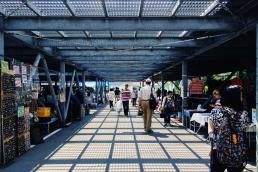
But I could only handle so much window-shopping. The bibliophile in me was itching and the answer to that obsession with yellowing pages is the Jimbocho Book Town. Halfway across Tokyo, the small district is located nearby major universities – lending the town an air of intellectual history with over 200 bookstores established since the early 20th century.
Many of these are second-hand and you’d be hard-pressed to find any books in English. But the sheer joy of mingling with books is enough to excite even the least passionate of readers.
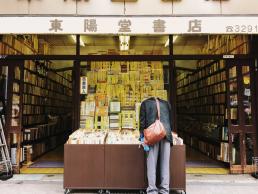
After a evening of rain, coffee and books, I head to Minato, the sun already dipping past the horizon. I emerged out of Akabanebashi Station, streetlights shimmering off the roads and in the distance past the tall buildings – Tokyo Tower.
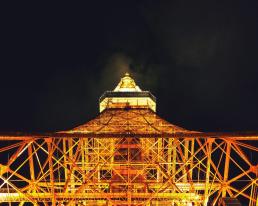
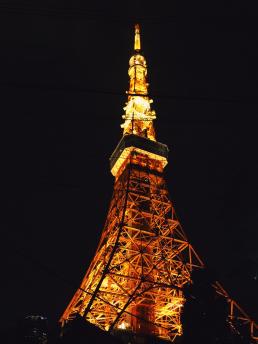
At 333m high, the tower commands an impressive view of the city. First-time visitors are not lost on its similarities to Paris’ Eiffel Tower that it’s modelled after (with 13m higher than the Eiffel).
This isn’t the first time that the Japanese’ obsession with French culture is visibly expressed. French culture’s influence can be seen across food to fashion; Paris romanticised with its cobblestone streets, chic cafe culture and croissant eating.
It isn’t unusual to see young women in Harajuku, Tokyo’s fashion town, drawing inspiration from French fashion. The French are romanticised to a point where Japanese travellers who visit Paris often return with mental breakdown known as the Paris Syndrome. This, often the result of facing the reality of the rude French and less than spotless city.
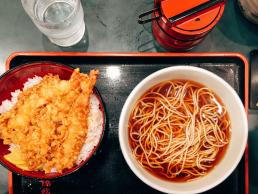
But I wasn’t done for the night. There was another observatory platform in Tokyo that also offered a rivalling view of the cityscape. Before heading into the subway, I dropped into a restaurant filled with sarariman, the Japanese salarymen and corporate slave. They were quiet, save for the occasional slurping and crunching. The only noise came from the kitchen, a sweaty chef running around in the kitchen – organising and crafting all the orders to piping-hot perfection.
I stopped.
In sarariman-frequented restaurants like these, chefs don’t take the orders directly. No. I spotted a machine at the corner, rich with images and text in the Hiragana and kanji. This time, I was alone with no romanised script to help me. I scrutinised the photos and its accompanying Japanese text. Then the solitary list to its right with buttons accompanying a single line of laminated words. In the end, I choose the ¥500 (RM19) shrimp tempura, rice and ramen. An honest meal, after a long day of work. I, too, ended up slurping and crunching my meal like the other suit-wearing middle-aged men around me.
When I left the restaurant, I saw a few others leaving, too – no doubt to either head straight home, or to hop over the the nearby izakayas for an obligatory social drink with their colleagues and bosses. I walked under the bright neon lights, taking a train to the Tokyo Metropolitan Government Building that’s due to close at 11pm.
At late night, the observatories on both North and South towers are flocked by visitors vying for a glittering view of Tokyo, the diamond and ruby lights pulsing alive in the near-sleepless city.
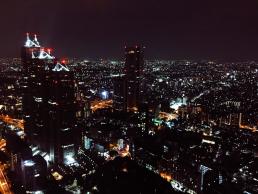
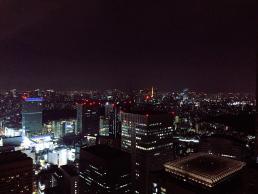
It’s almost midnight. I drop into a convenience store, the living heartbeats of the metropolis that run around the clock. I pick out my selection of ramen hot-cups, onigiri (riceballs) on discount and a hot can of coffee. I shelf out a few coins, thank the worker and head back outside – now in a sleet of drizzling rain.
As I draw up my hood, unwrap my onigiri and walk past an illuminated vending machine, I thought about what it means to be and breathe in this complex nation. Tokyo was a symbol of its own future: freeze-dried, wrapped and packaged to perfection. But if you look closely enough, you see its art in every detail – even if it’s a hot cup of seafood-flavoured ramen.
This feature was first published in The View.